Operation Buzzkill, Part 1: Grip Puppies
Sci-fi fans know the iconic quote from Frank Herbert’s Dune, “Fear is the mind-killer.” There are direct applications to motorcycling, and those will no doubt make future appearances in this space. Right now, however, I’m going to tweak this adage to discuss the problem of vibration, especially at the rider-handlebar connection: Vibration is the joy-killer. It eventually causes fatigue and pain in ones hands, reducing the pleasure of riding, limiting endurance, and compromising control – and therefore safety. Lasting bodily ailments can be created and/or exacerbated, as well.
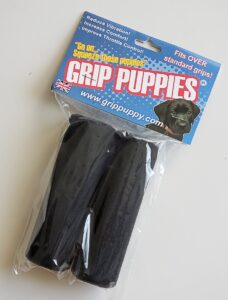 A motorcycle’s engine configuration has a lot to do with the type of vibration transmitted to the rider. Big, throbbing twins and singles typically send low-frequency/high-amplitude pulses through the bars that challenge gripping muscles to hang on. Small singles and multi-cylinder motors can create high-frequency/low-amplitude buzzing that numbs fingers and hands. Common solutions from the factory include internal counter-balancers, flexible motor mounts, and weights attached to the bar-ends or inside the bars to increase the amount of energy required to induce vibration, thereby changing the frequency at which handlebars resonate. Thicker, softer grips may transmit less vibration to a rider’s hands, and handlebar mounts may be equipped with rubber cushions (around the clamp-bar interface or where the mounts attach to the upper triple-clamp) meant to isolate bar from bike, albeit sometimes at the expense of front-end feedback and steering precision.
A motorcycle’s engine configuration has a lot to do with the type of vibration transmitted to the rider. Big, throbbing twins and singles typically send low-frequency/high-amplitude pulses through the bars that challenge gripping muscles to hang on. Small singles and multi-cylinder motors can create high-frequency/low-amplitude buzzing that numbs fingers and hands. Common solutions from the factory include internal counter-balancers, flexible motor mounts, and weights attached to the bar-ends or inside the bars to increase the amount of energy required to induce vibration, thereby changing the frequency at which handlebars resonate. Thicker, softer grips may transmit less vibration to a rider’s hands, and handlebar mounts may be equipped with rubber cushions (around the clamp-bar interface or where the mounts attach to the upper triple-clamp) meant to isolate bar from bike, albeit sometimes at the expense of front-end feedback and steering precision.
As riders suffer accumulating exposure to vibration – or simply age – physical discomfort or actual tissue damage can make the tasks of riding harder to sustain for long periods, or even perform at all. If factory vibration-reducing measures aren’t sufficient, what remedies are available from the aftermarket, and how much difference do they really make? These questions have personal relevance to me, since handlebar vibration is my biggest complaint about the F 800 GT I recently bought for long trips. Though supremely composed in all other dimensions, this bike’s parallel twin generates a frenetic buzz at the grips from 4500 rpm up. Most legal highway cruising tucks in just below this threshold, but hard acceleration and more aggressive exploitation of the chassis’s considerable sporting prowess are accompanied by obnoxious, distractingly intrusive vibes, contaminating an otherwise sublime riding experience. Even when traveling at a more sedate pace, my hands are often tired, numb, or achy within an hour – unacceptable for touring duty.
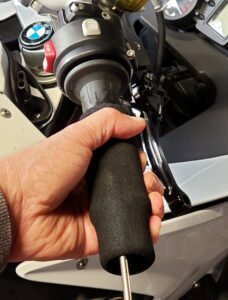 In this series, I’ll try several approaches to vibration-management, going from least to most expensive, with an eye to value. At $19.99 on Amazon (less elsewhere, but with shipping), the cheapest modification option is a pair of UK-made Grip Puppies. These are ultra-simple, thin-wall rubber sleeves, smooth on the inside and slightly spongy on the outside. They slip over a bike’s existing grips to provide a vibration-damping cushion. Actually, the term “slip” only applies when those grips are relatively featureless and uniformly narrow in diameter. Then the Grip Puppies’ interiors can be lubricated with a little soapy water and they’ll slide right on (once dry, they remain securely seated). Thick, heavily textured grips will prove more challenging. Obviously, bar-end weights must be removed and replaced.
In this series, I’ll try several approaches to vibration-management, going from least to most expensive, with an eye to value. At $19.99 on Amazon (less elsewhere, but with shipping), the cheapest modification option is a pair of UK-made Grip Puppies. These are ultra-simple, thin-wall rubber sleeves, smooth on the inside and slightly spongy on the outside. They slip over a bike’s existing grips to provide a vibration-damping cushion. Actually, the term “slip” only applies when those grips are relatively featureless and uniformly narrow in diameter. Then the Grip Puppies’ interiors can be lubricated with a little soapy water and they’ll slide right on (once dry, they remain securely seated). Thick, heavily textured grips will prove more challenging. Obviously, bar-end weights must be removed and replaced.
In the case of my F 800 GT, each grip’s large outboard flange presented a formidable hurdle during installation. I had to wrestle the Grip Puppies over these obstacles with the assistance of a thin metal rod, rotated around each grip while I pulled them across the remaining length. Toward the end of this process, I replaced the rod with a needle-nose attachment on my air compressor gun, injecting bursts of high-pressure air to lift the Grip Puppy away from the grip surface and reduce the related friction (even with soapy lubrication). The package explicitly states such pressurized facilitation is unnecessary, but this seems to be true only for flange-less grips. Maybe a tire bead lube would work better than soapy water and fulfill the promise, but this didn’t occur to me until afterward. Doh!
Grip Puppies are 127mm in length, but that measurement is subject to some expansion and compression. While the F 800 GT’s grips both share the same dimensions, with the space between inboard and outboard flanges measuring 118mm, I was able to fit the left side with an unaltered Grip Puppy by simply forcing it all the way on, since the rubber “absorbed” its own excess length. On the right, I was concerned about sustained pressure from my hand eventually squeezing a full-length Grip Puppy out over the outboard flange and potentially creating throttle rotation interference from contact with the bar-end. To avoid this (admittedly unlikely) possibility, I trimmed about 8mm off the Grip Puppy’s edge with a knife at the installation’s conclusion. While this posed a small risk of damage to the grip underneath, it seemed preferable to the geometric oddities that can arise from cutting a collapsed tube with a pair of scissors; pick your poison.
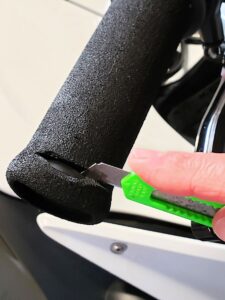 Once installed, the Grip Puppies had a neat and tidy appearance, and certainly felt plush compared to the hard, thin OEM grips. Vibration was noticeably reduced, maybe as much as 30-40%, by my subjective estimate. That would represent an outstanding cost/benefit ratio, except I found the Grip Puppies’ additional girth intolerably clumsy and awkward. I wear size medium gloves, so this may just be a result of having small-ish hands, but I felt less confident in my use of the clutch and brake levers, and experienced the grips as requiring more effort to, well, grip. The difference felt something like using pliers on a part almost too big for their jaws. You can still grab it, but without the same leverage you’d enjoy on a smaller piece.
Once installed, the Grip Puppies had a neat and tidy appearance, and certainly felt plush compared to the hard, thin OEM grips. Vibration was noticeably reduced, maybe as much as 30-40%, by my subjective estimate. That would represent an outstanding cost/benefit ratio, except I found the Grip Puppies’ additional girth intolerably clumsy and awkward. I wear size medium gloves, so this may just be a result of having small-ish hands, but I felt less confident in my use of the clutch and brake levers, and experienced the grips as requiring more effort to, well, grip. The difference felt something like using pliers on a part almost too big for their jaws. You can still grab it, but without the same leverage you’d enjoy on a smaller piece.
I would never have expected these dramatic consequences from adding such a small amount of external diameter. My naked grips measured 31mm OD, while the installed Grip Puppies read 41mm on the calipers. Perhaps the more relevant dimension is circumference, with the OEM pieces coming in at 96mm and the Grip Puppies at 132mm. Grip Puppies are advertised as allowing more precise throttle control with their larger circumference, presumably like a smaller throttle cable cam delivers finer increments of movement in relation to an equal-sized grip. This claim may be true in theory, but any such advantage was far outweighed by the overall reduction in control feel for me, even after hours of riding I’d hoped would get me used to them. The Grip Puppies’ extra layer slowed down the initial arrival of warmth from my heated grips, but ultimately had no significant negative impact on their effectiveness.
Grip Puppies have the advantages of low cost, no need to alter existing parts, and easy installation (at least on ideally shaped grips). They’re made of UV-, ozone- and oxidation-resistant foam, and get good reviews by many users online for their comfort and durability, including no water retention or loss of grip in the rain. According to their packaging, they’re appropriate for grips measuring 31.7mm to 38.8mm in diameter. Note that my (well-worn) grips were slightly thinner than this minimum. If you have large hands, the drawbacks I described may be no problem for you. However, these proved non-viable options in my personal quest to kill the F 800 GT’s buzz-killing buzzing. I will be looking for other solutions…
For more information or to purchase, visit grippuppy.com.
Keep going with Operation Buzzkill and find out Mark’s take on HVMP bar-ends in part 2.

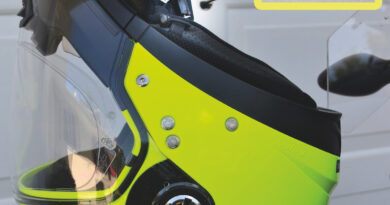

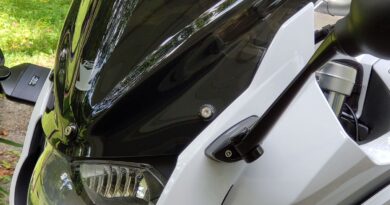
I’ve put 50,000 plus miles on my 2016 F800GT and agree that vibration becomes a problem over 4500 rpm..
I can also say that the vibration is much LESS than it was on the 2010 F800ST on which I logged 75,000miles.
Like you, I tried Grip Puppies, with the same result….. a perceived awkwardness in throttle control. Funny how that slight increase in grip circumference has such a negative impact.
I have found that my best solution so far is to wear riding gloves that have good padding in the palm area.
I love everything else about this bike…. so have learned to live with this slight irritation.
I have had Grip Puppies on both my 2004 Honda ST1300 and my current 2014 Yamaha FJR 1300. I wear a size large glove. Always ended up with sore wrists after even a short ride. I’m fine now for all day rides and the heated grips work fine (it helps living in southern California). Really enjoying “Why We Ride” during the pandemic and have my wife waiting in line to read as well.